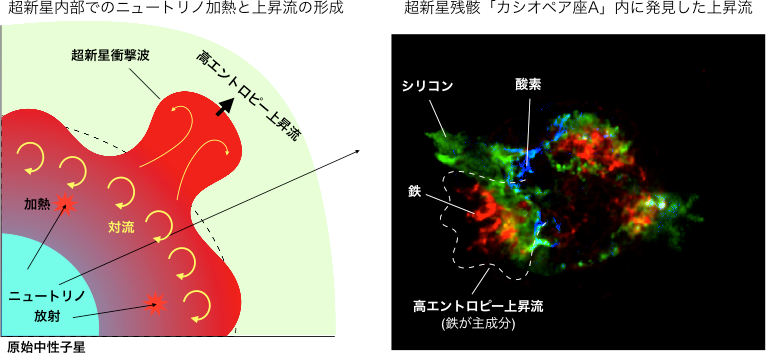DATE2021.04.22 #Press Releases
Supernova Engine of a Massive Star Revealed by X-ray Observations
Disclaimer: machine translated by DeepL which may contain errors.
-High-entropy upwelling due to neutrino heating drives the explosion.
RIKEN
Kyoto University
Graduate School of Science, The University of Tokyo
Rikkyo University
Summary
An international collaborative research group led by Dr. Hisanori Sato, a Basic Science Research Fellow (at the time of the research, now Assistant Professor at Department of Science, Rikkyo University) at the Tamagawa High Energy Astrophysics Laboratory, RIKEN Pioneering Research Director General, Dr. Shigehiro Nagataki, Senior Staff at the Nagataki Big Bang Laboratory, Associate Professor Keiichi Maeda at Kyoto University, Associate Professor Hideyuki Umeda and Researcher Takashi Yoshida (at the time of the research) at the Graduate School of Science, The University of Tokyo, and other researchers, has revealed that the supernova remnant "Cassiopeia A" is "neutron-influenced" based on X-ray observations by the Chandra satellite. (at the time) and their international research group have obtained the first observational evidence that the supernova remnant "Cassiopeia A" is a remnant of a gravitational collapse supernova that exploded triggered by neutrino heating, based on X-ray observations by the Chandra satellite.
Massive stars, which are more than 10 times the mass of the Sun, undergo a massive explosion called a "gravitational collapse supernova explosion" at the end of their lives. The mechanism of this explosion is said to be an extremely difficult problem in astrophysics, and it has been difficult to reproduce it even with large-scale theoretical calculations. Currently, the most plausible scenario is that the energy of some of the neutrinos released in large quantities when a star undergoes gravitational collapse heats up matter and causes a supernova explosion. The most important clue to this mechanism came from direct observations of neutrinos from supernova 1987A in 1987. However, there was no observational evidence to support neutrino heating, which is the essence of this scenario.
In this study, the international research group discovered traces of the high-entropy upwelling that rises during neutrino heating in the supernova remnant Cassiopeia A, and observationally revealed the mechanism of the "supernova engine" of this massive star. They also observed for the first time that titanium, a metal essential for our daily lives, was synthesized in large quantities in the upwelling during the supernova explosion.
This research was published in the online edition of the scientific journal Nature on April 21 (April 22 in Japan).

Figure: Upwelling formation process inside a supernova and supernova remnant Cassiopeia A
For more information, please visit the RIKEN website.


